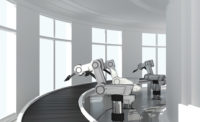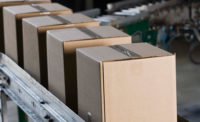From the early 1900s, when the first power-driven assembly line for vehicle production was introduced, manufacturers have sought ways to decrease labor costs, increase safety, improve turnaround times and implement efficient processes in an effort to positively impact their bottom line. The first assembly lines commonly included materials such as screws, bolts, nails and wet adhesives.
Today’s assembly lines have been transformed; engineered pressure-sensitive laminates have displaced other conventional fastening devices like rivets and wet adhesives to become a preferred fastening method. One of the more significant time and cost savers in assembly line production has been driven by the implementation of engineered pressure-sensitive laminates as alternative fastening solutions.

Figure 1. Engineered Laminate Layers
The Basics
Engineered laminates require only a slight initial external pressure to hold two surfaces together solely by surface contact. Depending on manufacturer specifications and end-use application, engineered laminate solutions can withstand adverse temperatures ranging from -40°F to more than 400°F. They are also capable of adhering to a variety of substrates and surfaces, including metal, wood, fiber, glass, rubber, and plastic, and they will often last or outlast a product’s lifecycle. Another advantage of engineered laminates is their ability to fasten dissimilar surfaces together.Manufacturers have discovered that they can realize greater efficiency in assembly line production with engineered laminates because these alternative fasteners can be customized for specific market segments. In other words, the same amount, size and thickness of laminate is used in applications in a specific segment each time, which offers better consistency without compromising the integrity of the substrate or end product.
Engineered laminates that are formulated specifically to work with manufacturers’ assembly lines bond quickly and help shorten the average assembly process. As a result, manufacturers can become more efficient and launch their products to market faster and at a better price.
As a comprehensive bonding solution, the engineered pressure-sensitive laminate is made up of multiple layers. Depending on the application, the engineered laminate could include a release liner, adhesive and carrier-all working together as one engineered solution that ensures product performance and value (see Figure 1).
Release liners protect and position the adhesive. Although the liner is discarded during installation, it needs to be right from the beginning for effective processing. Release liners should have good holdout, be heat resistant, and possess a consistent caliper for consistent die cutting. The carrier, which could be in the form of paper, film, foam or another specialty material, is the middle layer that must be compatible with the adhesive to ensure the best product performance.
Engineered pressure-sensitive laminates are formulated to adhere to specific substrates and can either be permanent or removable, depending on the end-use application. Permanent adhesives possess high ultimate adhesion to a variety of surfaces and are intended to last the lifecycle of the end-use product. Removable adhesives, on the other hand, are characterized by low ultimate adhesion to surfaces and are intended for applications that require removal of the adhesive without residues, stains or ghosting within the expected lifecycle of the end application. Engineered laminates are produced as either single- or double-coated adhesive constructions in a free-film or supported system.
All layers of an engineered laminate work together to give manufacturers an assembly solution that meets their specific needs. The benefits of working with engineered laminates far outweigh those of using mechanical or liquid fasteners. The ability to customize and pre-apply the laminate is one major benefit, but there are several other advantages to working with these fastening solutions.
Engineered Laminates vs. Traditional Mechanical Fasteners
Compared to mechanical fastening solutions, engineered laminates offer manufacturers the opportunity to work with fewer fastening components, thereby creating the ability to manufacture products with a more consistent quality in less time. In addition, engineered laminate-fastened solutions usually weigh less than finished products composed of mechanical fasteners.For example, prior to the incorporation of engineered laminates in cell phone applications, one cell phone contained more than 20 different non-pressure-sensitive fastening components. As cell phones gained popularity and began downsizing, manufacturers began to transition to engineered laminates. With this transition, the number of required components drastically decreased, which reduced labor, manufacturing costs, and the overall weight of the product while simultaneously enhancing the product’s design aesthetics to create a more appealing end-use product. The same can be said about many other electronic, automotive and appliance applications.
Engineered laminates also allow manufacturers to achieve enhanced structural integrity for finished products by eliminating unwanted holes or openings associated with mechanical fastening solutions and preventing potential rusting that metal-on-metal fasteners could cause. These engineered fasteners easily reduce stress on product joints, which can minimize product underperformance or failure. With the ability to increase flexibility in product development, engineered laminate solutions can be used to bond incompatible surfaces that would not be able to bond with traditional mechanical fastening solutions.
Unlike mechanical fasteners, engineered laminates form an insulating seal that prevents dust, liquids and in some cases unwanted sound and vibration from intruding. The convenience of working with engineered laminates also benefits today’s assembly lines. Because no elaborate equipment is required, manufacturers save money and can pass on these savings to consumers.
Engineered Laminates vs. Liquid Adhesives
Engineered laminates are also advantageous to manufacturers who usually work with wet adhesives as a fastening method. These manufacturers often experience less downtime with engineered laminates, because engineered fasteners do not require any drying or curing time, or extensive clean-up of the assembly area. In addition, engineered laminates emit little to no volatile organic compounds (VOCs), which reduces health risks to workers and improves sustainability. Because of the pre-applied concept, manufacturers can also ensure product consistency and performance with engineered laminates because the exact amount is applied each time.Assembly engineers find that line workers need minimal training and skill to work with engineered laminates. Because they can be engineered and die cut for specific assembly lines and surfaces, fewer hands are required to join product parts. This results in reduced labor costs, which could in turn affect price point competitiveness. This customizable characteristic of an engineered laminate ensures quality, consistency, precision and faster production time.
Engineered laminate fastening solutions also assure engineers that even the most delicate products will be protected during the assembly process because they are free of harmful solvents and do not require heat to activate-two things that can easily damage more sensitive products and lead to increased waste. Because engineered laminates offer immediate adhesion, assembly lines operate continuously without interruptions. There is no need to wait for long cure times, which means finished products can be handled or used immediately.
Conclusion
For today’s manufacturing industry, engineered pressure-sensitive laminates have the ability to streamline assembly processes, shorten lead times, reduce operational risks and increase profitability.For more information, visit www.mactac.com.

